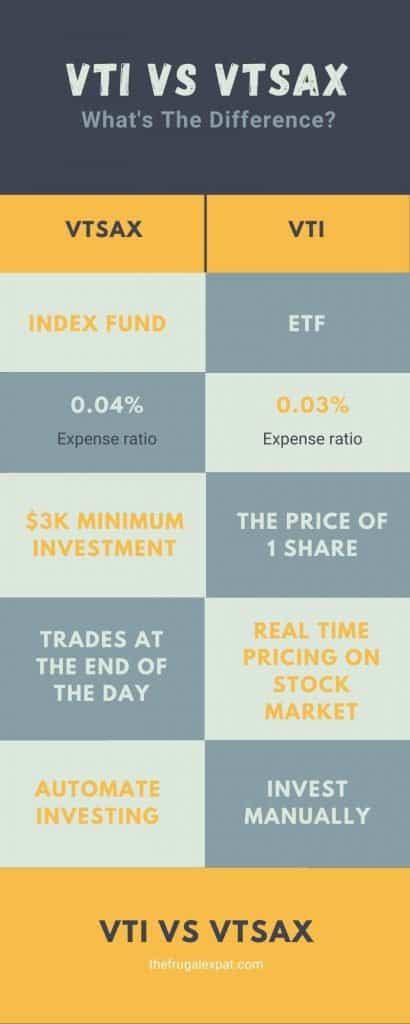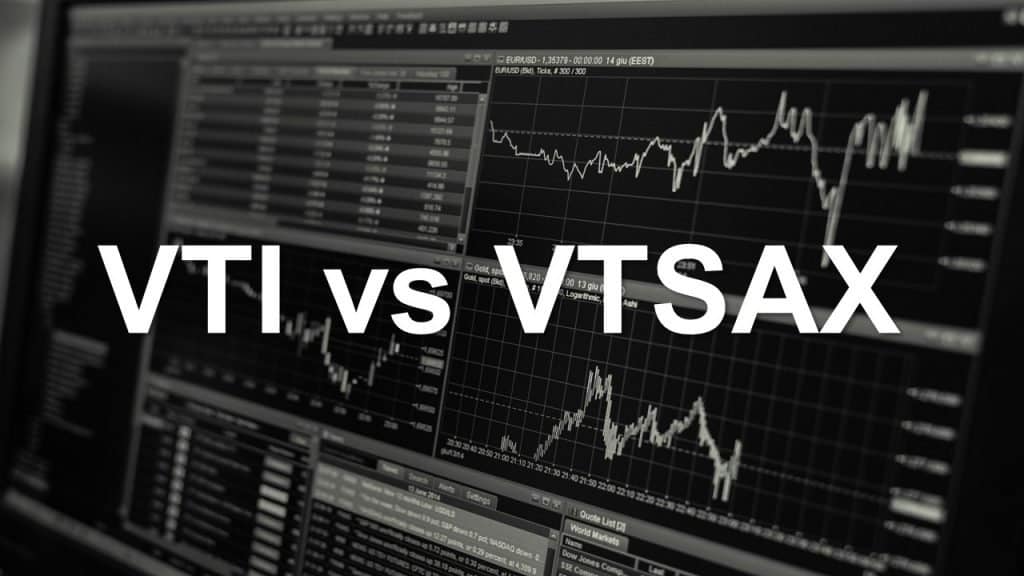In the world of investing in index funds, one usually reigns in as the best. That would be either VTI or VTSAX. These two funds are identical in composition but different in how they are represented. It is incredible to think that these two funds rule all with a $1 Trillion cap. What is the difference? Who wins as the best? Let’s dive deep into the differences between VTI vs VTSAX.
These are the two Vanguard Total Stock market index funds that are some of the most popular in the world. Finding the differences will be minute, but we will also find out why everyone likes them.
What is VTI and VTSAX?
That is the question that some of you may be asking. Entirely simply, they are index funds created by Vanguard. VTSAX was created in 1992 to be a total stock market index fund. VTI was created in 2001 to be a total stock market index fund ETF.
I know I am talking a lot about index funds. Let me quickly explain those to help you out.
VTI and VTSAX are both Index Funds:
John Bogle, the creator of Vanguard, came up with the concept of creating an index fund. This would be a type of mutual fund that is managed passively instead of actively. This would reduce the expense ratios and help average Joes create wealth without relying on fancy fund managers that charge huge expense ratios.
His first index fund came in 1975. It was an index fund that would mimic the S&P 500. An index fund would be a fund that would mimic a particular index.
That fund was top-rated. One of the most popular of John Bogle’s index funds was created in 1992, which was VTSAX.
In 2001, VTI was created to be an Exchange Traded Fund (ETF) of VTSAX. Both of these funds would deliver the returns of the total U.S. stock market. You would never beat the market but get the same returns.
If the market goes up 10%, your returns would be at 10%. It was a way to make things simple. Simple is easy and effective for an average person.
Why are VTI and VTSAX So Popular?
They are so popular because they work. These two simple funds allow the average person to get a piece of every company in the U.S. stock market. That sounds way too simple for the average person, but as long as you believe in the U.S. stock market, then it will continue to go up in price.
They are:
- Simple
- Diversified
- Set it and forget it
- Low expense ratios
- Not an actively managed fund
- A history of increasing value over time.
This has allowed many different people to get rich by just holding onto these simple index funds.
J.L. Collins, the famous author of The Simple Path to Wealth, emphasis the ownerships of VTSAX. He often mentions it that you will walk away from the book with one thing on your mind, VTSAX.
Taylor Larimore, in his Bogleheads 3-Fund Portfolio, talks about making a 3-Fund portfolio. This portfolio would be VTI, VXUS, and BND.
Rick Ferri, in his Core-4 portfolio, also advocates using VTI as a majority position.
With so many of these famous authors and financial advisors advocating these funds, you must wonder why you are not holding onto them. They are super popular because they work. Creating a portfolio to help you can financial independence is a huge plus for these funds. They are efficient, simple, and create wealth.
The biggest question is which one do I choose. Do I select VTI or VTSAX? What are the differences between VTI vs VTSAX?
What are the Differences Between VTI vs VTSAX?
These are almost two identical funds operating within the same capacity. What could the differences be? Which one would you choose? Let's find the differences between VTI vs VTSAX.
Difference #1: The Minimum Investment
As we look at these two funds, there is a difference in the minimum investment.
VTI: The price of the share would be the minimum investment
VTSAX: The intial minimum investment would be $3000
Since VTSAX is a type of Mutual Fund, the minimum investment would be $3000. After you have that $3000 in the fund, you can invest as much or as little as you would like. If you have $10, you can invest that; you can invest that if you have $1000.
To start, you need to have the fund funded with $3000. Afterward, you can invest as much or little as you like.
With VTI, it starts with the price of the ETF. If VTI costs $145, then you need that amount of money to purchase shares. If the price is closer to $230, then you need $230 to purchase one share. As the price goes up, so makes the amount of money you need to buy individual shares.
Difference #2: Real-Time Pricing
The next difference is the Real-Time Pricing of both VTI vs VTSAX.
VTSAX is a mutual fund. The pricing of each share comes at the end of the day. If the market goes up and the price will be affected at the end of the day.
VTI is an ETF, which can be traded throughout the day like a stock. The price will fluctuate throughout the day. If you notice the market collapses at some point during the day, you could buy the stock at a lower price than it would be at the end of the day.
It all depends on you. You can opt into knowing how the price goes up and down throughout the day with VTI, or be patient and allow the price to be mad at the end of the trading day.
Difference #3: Expense Ratios
The expense ratio is how much the fund costs to operate. Suppose a fund has a 0.05% Expense ratio. Then it will cost $5 per $10,000.
VTSAX has an expense ratio of 0.04%. It will cost $4 per $10,000 invested.
VTI has an expense ratio of 0.03%. It will cost $3 per $10,000 invested.
Their expense ratios are very low, and it will depend on you. It is not the biggest difference, but you have your choice of saving. When you buy and hold index funds having low costs makes them attractive. The great thing about both VTI and VTSAX is the low cost associated with the two funds.
If you take a look at the differences of SPY vs VOO, you will notice that SPY has an expense ratio of 0.09% and VOO has an expense ratio of 0.03%, giving you the ability to have slightly higher return with the low costs associated with the funds.
Difference #4: Automatic Investments & Withdrawals
Being able to invest automatically helps to take the human element out of the equation. Fidelity did internal reviews from 2003 to 2013 to see which investors performed the best. They found that the investors that were either dead or inactive performed the best.
Investors that just let automation take the course instead of messing with their accounts gained the best returns. Automation is important.
VTSAX allows for automation. The ability of not needing to purchase a share at a market price during the day allows it the flexibility to take $100 a day, a month, or a year and buy shares at the end of the day. It could be less, but you can automatically set up buy orders.
VTI has no automation. It is bought throughout the day as the price will fluctuate. So you must go in and create buy orders when you purchase or even sell. The human element affects your investments.
Automation can really help take that human element out of the way and allow automation to take place.
If you really want some unique automation for VTI, I would recommend a service called M1 Finance. It was a great way to automate your investments and invest in products like VTI
VTI and VTSAX are Identical Investments:
They are both index funds. They have low expense ratios, and they have an excellent stock portfolio. Their 10 most significant holdings of stock are as follows:
- Apple
- Microsoft Corp
- Alphabet Inc
- Amazon.com Inc.
- Facebook Inc.
- Tesla Inc.
- Berkshire Hathaway Inc.
- Nvidia Corp
- JP Morgan Chase & Co.
- Johnson & Johnson
The Returns of these Funds:
VTSAX:
- 1 Year: 38.95%
- 3 Year: 18.12%
- 5 Year: 17.39%
- 10 Year: 15.15%
- Inception: 8.42%
VTI:
- 1 Year: 38.98%
- 3 Year: 18.12%
- 5 Year: 17.39%
- 10 Year: 15.16%
- Inception: 8.86%
These funds are very similar indeed. They are identical, and apart from the few differences, you cannot go wrong with either of these funds.

Final Thoughts:
VTI vs VTSAX are two funds you cannot go wrong with. They are significant funds with low expense ratios and do similar things. VTI can give you more flexibility with having less money and buying the ETF on other exchanges like M1 Finance, but VTSAX also gives you automatic investing.
When looking at a fund that will help you reach financial independence, you cannot go wrong with looking at either of these funds. They are not actively managed mutual funds, and therefore will not bring on any unnecessary capital gains tax. They may not outperform the total stock market, but they will match it, which to me is a great thing.
The choice is yours to choose. They will both give you similar returns and owning some of the best companies in the world. Each person has a different way of investing. I use VTSAX in my Roth IRA, but I use VTI in my taxable brokerage account. With these two as your options, you cannot have better funds to invest in.
Which one would you choose?
Related Posts:
- VOO vs VTI: Which ETF Is Better?
- VTSAX vs VFIAX: Which One Would You Choose?
- ETFs vs Mutual Funds: What's The Difference?

I’m Steve. I’m an English Teacher, traveler, and an avid outdoorsman. If you’d like to comment, ask a question, or simply say hi, leave me a message here, on Twitter (@thefrugalexpat1). Many of my posts have been written to help those in their journey to financial independence. I am on my journey, and as I learn more I hope to share more. And as always, thanks for reading The Frugal Expat.








Great write-up! I typically lean toward VTSAX over VTI, but it’s been quite some time since I really looked into it, and had honestly lost track of most of these distinctions. So thanks for the breakdown. You can’t go wrong with either, but this is helpful in thinking about which is better for different people’s situations!
I agree Sam. Sometimes people cannot invest in VTSAX directly so they can easily buy VTI on other brokerages like M1 Finance, Fidelity, and Schwab. Different situations for different people.
I have a big chunk of my assets invested with Vanguard. A couple of years ago they contacted me and said they were switching their clients from VTSAX admiral shares to VTI etf shares. They said it was less expensive so it was in their client’s best interests to make the switch.
Steve, the expense ratio is 0.03% for VTI and 0.04% for VTSAX. It is true that VTI is less expensive. Saving money is always a great thing!
Great article – thank you! I’m curious about what you said there at the end: VTSAX in your Roth and VTI in your taxable account.
Could you elaborate on this, please? What motivated your choice for each account?
You could put VTI in both. I like VTI in taxable account because it is more tax efficient than VTSAX. If you wanted to have both in your portfolio then you could have the one that is less tax efficient in a Roth account. ETFs in general are more tax efficient because they do not distribute as many capital gains. VTI has a 0.49% tax ratio while VTSAX has a 0.70% tax ratio making VTI a better choice in a taxable account.